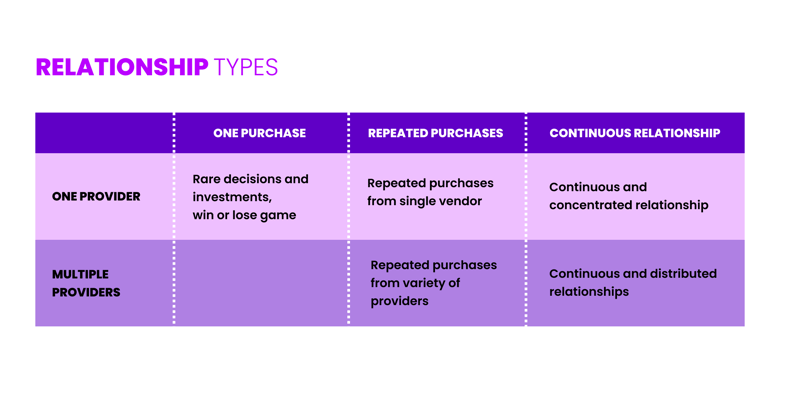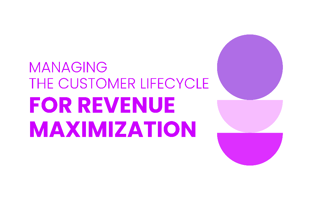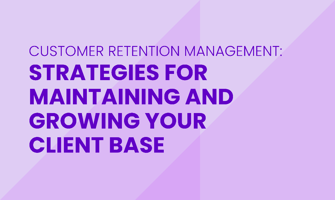Funnel is great way to visualize the ideas and set metrics for a customer journey, but it’s better...
Customer relationship types and business model innovation
Early in my career marketing was all about customer acquisition. Then management realized, that managing churn was important. Now, both ends of the customer relationship had become hot topics. Then came Service Design, which is one of the most important new value-driving approaches that have matured in the past decade. Service Design concentrates on service moments and jobs-to-be-done point by point. Important, but still insufficient. In our opinion its time to turn to the next and more holistic approach, which is about Customer Relationship Design, ARPA and Lifetime value.
Designing customer relationships instead of single services takes into account the company's full capacity to offer value for customers. Every offering and capability that a company has should be maximally delivered as value for a customer. To maximize customer success with everything you do, you need to design customer relationships as optimal outcomes. This approach also enables you to reconsider your business model and earning logic.
A clear megatrend is the decline of ownership as a preferred way of buying and its replacement by usage-based monthly fees and the right to use inventory. This is evidenced by how we have moved from buying or renting music or videos to using Netflix, HBO Max, and Spotify – or from buying a car to leasing it. Even airplane engines are being rented by flight hours rather than purchasing them (Rolls Royce is driving this change).
In B2B, the entire software business has moved to the SaaS model. Often, this type of logic disruption is the key to growing your business disproportionately. That is why modeling different types of customer relationship types is supremely important.
Each market type has distinct behavioral patterns that set the stage for optimizing the path to purchase, the experience path, and the importance of frequency and continuous experiences.
For example, for female consumers, fashion-shopping behavior typically revolves around a ‘day of shopping’. The shoppers spend time making discoveries by walking from store to store or visiting multiple online fashion stores. This is a less prominent pattern in B2B markets. Still, the path to purchase can be transformed to the direction of serial buying if, for example, the brand can earn a position as the customers' advisor and source of inspiration.
If a customer adopts a brand as part of their habits boosted by trust, it is possible to increase the share of wallet and market share with existing customers by winning a larger share of spending. However, new customer acquisition must always be on because of the double jeopardy law.
5 CUSTOMER RELATIONSHIP TYPES
We can distinguish five customer relationship types that have significant differences and in which very different tools are needed to improve customer experience, customer lifetime value, and profitability.

Figure: The different types of customer relationships
- One partner–single transaction
The customer is often new to the situation and feels insecure. These decisions occur rarely, often only once or twice in a lifetime, which is why there is a weak element of past experiences. In B2B, these are decisions like investing in a new ERP or CRM system, making infrastructure investment decisions, or, e.g., outsourcing some functions. B2B companies often use specialist consultants to help with these decisions. If a consultant is involved, this changes the game from the direct-to-customer game. -
Multiple partners–multiple transactions
This market could be described as a shopping market. The customers show little loyalty and frequently buy from different vendors offline and online. Fashion is a great example, as are restaurants or travel. Behavioral changes in this market can be rapid and drastic. In B2B business commodities represent this market type.
-
Single partner – multiple transactions
In this market, customers make a decision to buy for each individual purchase and decide to come to the same vendor each time. Great examples about such behavior are daily grocery purchases, daily lunch, hairdresser/barber visits, car maintenance, tire changes, visits to the optician, etc. In B2B, you can create agreements about preferred partner status and win a higher share of a company's orders. This market is based on habits or often relationships to individual persons like a consultant or a salesperson. In this market, individual transactions can be small, but average revenue per customer or lifetime value of a customer can be quite significant. Agreements can be very powerful when there are multiple buyers inside the company buying for individual needs. Business travel agencies are a great example of this model. -
Multiple partners – continuous relationship
Currently, the growth in digital services is breeding this kind of market. Some examples include multiple streaming services for online video, sports, or games, or different types of SaaS services in the B2B segment. More traditional examples are banking and teleoperator services. In these sectors, one company could serve a customer's needs, but most customers buy from multiple partners – e.g., getting multiple credit cards from different vendors. Defecting customers and negative churn are constant threats in these continuous relationships. The upside is that earning customers' trust and having multiple offering areas can double or triple the customer's value and ARPU (average revenue per user) or ARPA (average revenue per account) in B2B, which results in growing revenue and retention and reducing risks. -
One partner – continuous relationship
This is rarer and exclusive market logic in which electricity and water agreements are the best examples. In this kind a of relationship, the customer has only one partner with an ongoing service agreement. Such agreements are more common in the B2B environment: e.g., ICT, cleaning services, bookkeeping, outsourcing solutions, financial services, media and marketing services, etc.
implications to data driven management
Holistic analysis with 180ops helps companies understand what is an ideal offering portfolio for each individual customer. Offering penetration level is a direct influencer for ARPA, lifetime value and retention. This approach has most value for repeated purchases and continuous customer relationship types. Single and rare investments can be modelled if there is enough data (hundreds of cases), but they require validation to make certain that the data is capable of giving reliable and valuable answers. In case the first purchase decision leads to ongoing after sales, that is definitely something that we can work with.
For the creation of strategic segmentation, sales budgeting and Revenue Operations collaboration between sales, marketing and customer success 180ops drives very high value. However, the understanding of customer relationship logic and underlying customer behavior for innovation is a key to decision making and game changing innovations.




